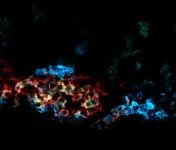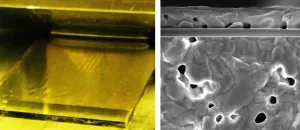(Press-News.org) A new process that lets scientists chemically cut apart and stitch together nanoscopic layers of two-dimensional materials — like a tailor altering a suit — could be just the tool for designing the technology of a sustainable energy future. Researchers from Drexel University, China and Sweden, have developed a method for structurally splitting, editing and reconstituting layered materials, called MAX phases and MXenes, with the potential of producing new materials with very unusual compositions and exceptional properties.
A “chemical scissor” is a chemical designed to react with a specific compound to break a chemical bond. The original set of chemical scissors, designed to break carbon-hydrogen bonds in organic molecules, was reported more than a decade ago. In a paper recently published in Science, the international team reported on a method to sharpen the scissors so that they can cut through extremely strong and stable layered nanomaterials in a way that breaks atomic bonds within a single atomic plane, then substitutes new elements — fundamentally altering the material’s composition in a single chemical “snip.”
“This research opens a new era of materials science, enabling atomistic engineering of two-dimensional and layered materials,” said Yury Gogotsi, PhD, Distinguished University professor and Bach chair in Drexel’s College of Engineering, who was an author of the research. “We are showing a way to assemble and disassemble these materials like LEGO blocks, which will lead to the development of exciting new materials that have not even been predicted to be able to exist until now.”
Gogotsi and his collaborators at Drexel have been studying the properties of a family of layered nanomaterials called MXenes, that they discovered in 2011. MXenes begin as a precursor material called a MAX phase; “MAX” is a chemical portmanteau signifying the three layers of the material: M, A, and X. Applying a strong acid to the MAX phase chemically etches away the A layer, creating a more porously layered material — with an A-less moniker: MXene.
The discovery came on the heels of worldwide excitement about a two-dimensional nanomaterial called graphene, posited to be the strongest material in existence when the team of researchers who discovered it won the Nobel prize in 2010. Graphene’s discovery expanded the search for other atomically thin materials with extraordinary properties — like MXenes.
Drexel’s team has been assiduously exploring the properties of MXene materials, leading to discoveries about its exceptional electrical conductivity, durability and ability to attract and filter chemical compounds, among others. But in some ways, the potential for MXenes has been capped from their inception by the way they’re produced and the limited set of MAX phases and etchants that can be used to create them.
“Previously we could only produce new MXenes by adjusting the chemistry of the MAX phase or the acid used to etch it,” Gogotsi said. “While this allowed us to create dozens of MXenes, and predict that many dozen more could be created, the process did not allow for a great deal of control or precision.”
By contrast, the process that the team — led by Gogotsi and Qing Huang, PhD, a professor at the Chinese Academy of Sciences — reported in its Science paper explains that, “chemical scissor-mediated structural editing of layered transition metal carbides,” is more like performing surgery, according to Gogotsi.
The first step is using a Lewis acidic molten salt (LAMS) etching protocol that removes the A layer, as usual, but is also able to replace it with another element, such as chlorine. This is significant because it puts the material in a chemical state such that its layers can be sliced apart using a second set of chemical scissors, composed of a metal, such as zinc. These layers are the raw materials of MAX phases, which means the addition of a bit of chemical “mortar” — a process called intercalation — lets the team build their own MAX phases, which can then be used to create new MXenes, tailored to enhance specific properties.
“This process is like making a surgical cut of the MAX structure, peeling apart the layers and then reconstructing it with new and different metal layers,” Gogotsi said. “In addition to being able to produce new and unusual chemistries, which is interesting fundamentally, we can also make new and different MAX phases and use them to produce MXenes that are tailored to optimize various properties.”
In addition to building new MAX phases, the team also reported on using the method to create MXenes that can host new “guest atoms” that it previously would not have been chemically able to accommodate — further expanding the family of MXene materials.
“We expect this work to lead to a major expansion of the already very large space of layered and two-dimensional materials,” Gogotsi said. “New MXenes that could not be produced from conventional MAX precursors are becoming possible. Of course, new materials with unusual structure and properties are expected to enable new technologies.”
The next step for this research, according to Gogotsi, is the delamination of two- and three-dimensional layered carbides, as well as metal intercalated two-dimensional carbides, into single- and few-layer nanosheets. This will allow the researchers to characterize their fundamental properties to optimize the new materials for use in energy storage, electronics and other applications.
END
Nano cut-and-sew: New method for chemically tailoring layered nanomaterials could open pathways to designing 2D materials on demand
2023-03-16
ELSE PRESS RELEASES FROM THIS DATE:
Fomepizole helps overcome antibiotic-resistant pneumonia in mice
2023-03-16
Pneumococcal disease leads to over three million hospitalizations and hundreds of thousands of deaths annually. A study publishing March 16th in the open access journal PLOS Biology by Carlos J. Orihuela at the University of Alabama at Birmingham, Alabama, United States, and colleagues suggests that the FDA-approved drug Fomepizole may reduce disease severity in the lungs of mice with some forms of bacterial pneumonia and enhance the efficacy of the antibiotic erythromycin as well.
Streptococcus pneumoniae is the leading cause of community-acquired ...
Losing key type of pancreatic cell may contribute to diabetes
2023-03-16
Losing Key Type of Pancreatic Cell May Contribute to Diabetes
Multiple types of beta cells produce insulin in the pancreas, helping to balance blood sugar levels. Losing a particularly productive type of beta cell may contribute to the development of diabetes, according to a new study by Weill Cornell Medicine investigators.
In the study, published March 16 in Nature Cell Biology, Dr. James Lo, associate professor of medicine at Weill Cornell Medicine, and colleagues measured gene expression in individual beta cells collected from mice to determine how many different types of beta cells exist in the pancreas. The team discovered four distinct beta cell types, including one that stood out. ...
Spin-off: 12 million euros for a novel gene editing platform
2023-03-16
The TU Dresden Spin-off Seamless Therapeutics Launches with $12.5M Seed Financing to Advance Transformative Gene Editing Platform Based on Programmable Precision Designer Recombinases in Dresden
Seed round co-led by Wellington Partners and Forbion, with additional non-dilutive financial support from the BMBF (GO-Bio funding) enables maturation of the proprietary platform and pipeline towards first clinical evaluation
Seamless Therapeutics, a Dresden based start-up of the Technische Universität Dresden, today announced a $12.5 million (€11.8M) seed financing round which will accelerate further development ...
Paxlovid associated with lower risk of hospital admission
2023-03-16
PASADENA, Calif. — A Kaiser Permanente study confirms the benefit of nirmatrelvir-ritonavir, also known as Paxlovid, as an early-stage treatment to prevent hospitalization for people with mild to moderate COVID-19, regardless of prior immunity or age. The study was published March 15, 2023, in Lancet ID.
“Among Kaiser Permanente members in Southern California who tested positive for coronavirus infection, receiving Paxlovid within 5 days of the start of COVID-19 symptoms was associated with substantial reductions in the risk of hospital admission or death,” said Sara Tartof, PhD, the senior author of the study and an epidemiologist with the Kaiser ...
Children at risk of multiple sclerosis often go undetected in early stages
2023-03-16
Criteria used by neurologists to assess for multiple sclerosis (MS) in adults may fail to identify the illness in children with imaging suspicious for the disease, an oversight that could delay treatment of the disease at its earliest stages, according to a Rutgers study.
Magnetic resonance imaging (MRI) is the primary tool used for diagnosis of MS, and doctors have applied various standards over the years to classify those most likely to develop the disease. The most recent standard, known as the McDonald criteria, was last updated in 2017.
In some cases, imaging suspicious for MS is found incidentally ...
Breakthrough in the understanding of quantum turbulence
2023-03-16
Researchers have shown how energy disappears in quantum turbulence, paving the way for a better understanding of turbulence in scales ranging from the microscopic to the planetary.
Dr Samuli Autti from Lancaster University is one of the authors of a new study of quantum wave turbulence together with researchers at Aalto University.
The team’s findings, published in Nature Physics, demonstrate a new understanding of how wave-like motion transfers energy from macroscopic to microscopic length scales, and their results confirm ...
Selwyn Rogers named associate editor of prestigious New England Journal of Medicine
2023-03-16
Renowned University of Chicago Medicine trauma surgeon Selwyn O. Rogers Jr., MD, MPH, has been named an associate editor of the New England Journal of Medicine (NEJM), effective March 16.
The founding director of the UChicago Medicine Trauma Center, Rogers is a Professor of Surgery at UChicago and Chief of Trauma and Acute Care Surgery at its 1,296-bed academic health system based on Chicago’s South Side.
A leading public health expert whose research focuses on the healthcare needs of underserved populations — particularly those impacted by intentional violence — he is the first surgeon in more than a decade to serve as an associate editor at NEJM, ...
Perovskite solar cells from the slot die coater - a step towards industrial production
2023-03-16
Metal halide perovskites are considered to be a particularly low-cost and promising class of materials for next-generation solar modules. Perovskite solar cells can be produced with coating processes using liquid inks made from precursor materials and various solvents. After coating, the solvents evaporate and the perovskites crystallise to form a more or less homogeneous layer.
Options for upscaling
Prof. Dr. Eva Unger's team at Helmholtz-Zentrum Berlin has extensive expertise in solution-based processing methods and is investigating options for upscaling. "Perovskite photovoltaics is the best solution-processable PV technology available," says Eva Unger, ...
Researchers highlight nucleolar DNA damage response in fight against cancer
2023-03-16
Cancer, which affects millions every year, requires proteins to spread through the body. In a new strategy to beat the wide-ranging disease, scientists are sabotaging its protein factories.
In a new forum paper published in Trends in Biology, researchers from the University of North Carolina at Charlotte encapsulated the young field of nucleolar DNA damage response (DDR) pathways. The review highlights six mechanisms by which cells repair DNA damage, including one which was published five months ago in Nucleic Acids Research by the same authors. By attacking these mechanisms, future applied researchers will be able to ...
Food security: New tool can forecast food insecurity up to 30 days in advance
2023-03-16
A new tool that can be used to forecast the prevalence of individuals within a country that may have insufficient access to food — known as food insecurity — up to 30 days into the future is presented in a study published in Scientific Reports. The authors suggest that the tool could aid decision makers in countries at risk of food insecurity and help facilitate more timely responses.
Elisa Omodei and colleagues developed the tool using food consumption data from Burkina Faso, Cameroon, Mali, Nigeria, Syria and Yemen — all countries that have recently ...





